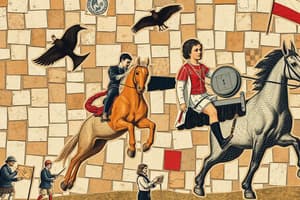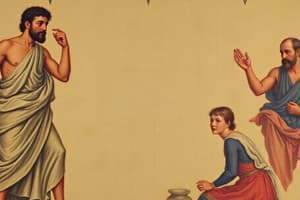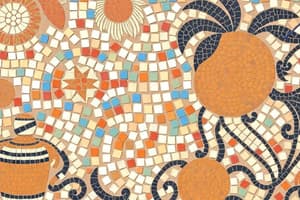Podcast
Questions and Answers
What technique was commonly used for Roman paintings?
What technique was commonly used for Roman paintings?
- Fresco technique (correct)
- Watercolor
- Oil painting
- Acrylic
Roman paintings primarily depicted portraits and landscapes.
Roman paintings primarily depicted portraits and landscapes.
True (A)
What is the main innovation of Roman painting compared to Greek painting?
What is the main innovation of Roman painting compared to Greek painting?
Development of landscape painting
What is the earliest known panel painting?
What is the earliest known panel painting?
Which method uses water-based pigments on freshly applied plaster?
Which method uses water-based pigments on freshly applied plaster?
What were the themes of Egyptian paintings?
What were the themes of Egyptian paintings?
Cave paintings were predominantly used for ceremonial purposes during the prehistoric era.
Cave paintings were predominantly used for ceremonial purposes during the prehistoric era.
What color palette was used in Egyptian paintings?
What color palette was used in Egyptian paintings?
The Great Hall of the ______ is a section of the Cave of Lascaux.
The Great Hall of the ______ is a section of the Cave of Lascaux.
What is a mosaic?
What is a mosaic?
Flashcards are hidden until you start studying
Study Notes
Tomb of the Diver (Paestum, 480 BCE)
- Significant archaeological site; provides insight into ancient burial practices and art.
Paintings from the Roman Era
- Roman paintings often imitated Greek styles.
- Utilized fresco technique with vivid backgrounds.
- Walls were designed in a tic-tac-toe grid layout.
- Employed multi-point perspective for depth.
- Used trompe-l'œil to create optical illusions.
- Subject matter included animals, daily life, mythology, and landscapes.
- Roman paintings innovated by establishing landscape painting as a distinct genre.
Panel Painting
- Created on flat wooden panels; can be single or multiple interconnected panels.
- Many early panel paintings have deteriorated due to organic materials used.
- Pitsa Panel is the earliest known example, dating from 540-530 BCE.
Tomb / Wall Painting
- Commonly found during the classical period.
- Techniques included fresco, tempera, and encaustic methods.
- Characterized by sharp outlines and limited remaining samples due to material fragility.
- Featured true fresco technique using limestone mortar, illustrating social scenes like symposia.
Paintings from Classical Greek Era
- Found on vases, panels, and tombs; depicted naturalistic figures in action.
- Frequent subjects included battles, myths, and everyday life.
- Showcased understanding of linear perspective and realism.
Most Common Methods of Greek Painting
- Fresco: Water-based pigments on wet plaster, ideal for murals; durable and matte.
- Encaustic: Used hot wax mixed with pigments; originally developed for shipbuilding.
Judgement of Paris (370-330 BCE)
- A notable example of classical painting illustrating mythological narratives.
Paintings From The Pre-Historic Era
- Found in cave systems; believed to serve communication or ceremonial purposes.
- Prehistoric art depicted animals accurately in proportion.
Cave of Lascaux (15,000-10,000 BCE)
- Site known for large animal paintings, discovered in 1940 and protected as a historic monument.
- Contains nearly 2,000 figures, including animals and abstract designs.
- Notable areas include the Great Hall of the Bulls and the Chamber of Felines.
Paintings from Ancient Egypt
- Aimed to enhance the deceased's afterlife with pleasant imagery.
- Themes revolved around journeys to the underworld with gods and protective deities.
- Paintings were largely symbolic, with figures shown in profile.
- Predominant colors were red, black, blue, gold, and green, derived from mineral pigments.
Sarcophagus of Tutankhamen (XVIII Dynasty, 1362-1253 BCE)
- These paintings depict the king's life and his journey after death.
Mosaic
- Art form created from small pieces of colored materials; used for decoration.
- Example: Roman floor mosaic from the House of Fun Pompeii, illustrating Alexander the Great's battle against Darius III, dated to 100 BCE.
Fresco from the Villa of Mysteries (Pompeii, 80 BCE)
- Noteworthy for its preservation and intricate details.
Head of Alexander
- An important ancient work, indicative of the high artistic standards achieved during this period.
Studying That Suits You
Use AI to generate personalized quizzes and flashcards to suit your learning preferences.




